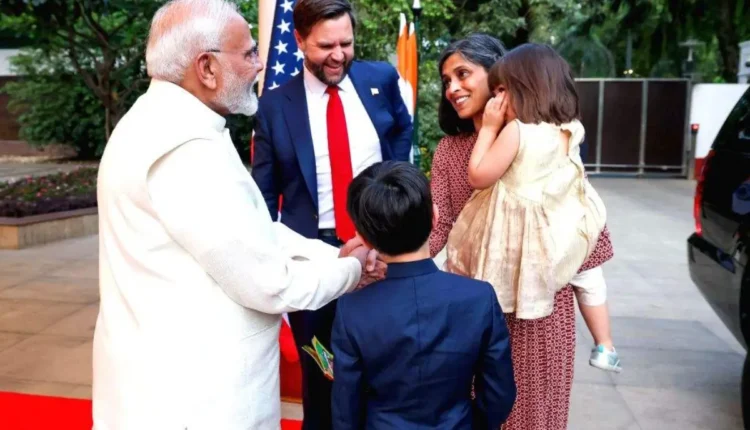PM Modi Hosts JD Vance as India-US Bilateral Trade Agreement Talks Accelerate
PM Modi, JD Vance Welcome Progress on India-US Bilateral Trade Agreement
In a key diplomatic stride towards redefining global trade dynamics, India and the United States on Monday lauded “significant progress” in finalizing the first tranche of the India-US Bilateral Trade Agreement. The high-level discussion took place at Prime Minister Narendra Modi’s official residence, where he warmly welcomed US Vice President JD Vance and his family for an intimate yet impactful evening.
The meeting comes at a critical juncture as both nations aim to finalize a comprehensive trade agreement that promises to enhance market access, reduce tariffs, and unlock new avenues of cooperation in defence, energy, and strategic technologies. Prime Minister Modi, Vice President Vance, and their respective delegations—including External Affairs Minister S. Jaishankar and National Security Adviser Ajit Doval—underscored the importance of this evolving partnership for global prosperity and security.
A Dinner of Diplomacy and Vision
Hosted by Modi with signature Indian hospitality, the dinner was attended by cabinet ministers and saw Vice President Vance accompanied by Second Lady Usha Vance and their three children—Ewan, Vivek, and Mirabel. Beyond formality, the gathering symbolized a shared commitment to a future shaped by cooperation, innovation, and mutual respect.
“This evening, we reviewed the fast-paced progress since my visit to the US and my discussions with President Trump,” PM Modi shared in a social media post. “We are committed to mutually beneficial cooperation, including in trade, technology, defence, energy and people-to-people exchanges.”
Trade Talks: From Tariffs to Trust
Central to the conversation was the advancement of the India-US Bilateral Trade Agreement, currently structured around key areas like tariffs, market access, and trade facilitation. The deal has gained urgency after former President Donald Trump paused his “Liberation Day” reciprocal tariffs on 60 countries—including a 26% tariff on Indian goods—until July, opening a vital window for swift negotiation.
The Indian negotiating team is set to visit Washington on April 23 to hammer out details of an interim agreement. This deal, insiders revealed, will address early wins such as agricultural exports, automobiles, and alcoholic beverages—while fiercely guarding the interests of Indian manufacturers. The proposed agreement spans 19 chapters, covering everything from rules of origin and customs regulations to non-tariff barriers.
Strategic Alignment for a New Era
Modi and Vance reaffirmed that the India-US Bilateral Trade Agreement isn’t merely about commerce—it’s a cornerstone of the broader India-US Comprehensive Global Strategic Partnership. Both leaders reviewed bilateral achievements across critical sectors, from cutting-edge defence technology to green energy and digital innovation.
The readout emphasized “continued efforts toward enhancing cooperation in energy, defence, strategic technologies, and other areas,” and both sides assessed their progress “positively.”
The meeting also covered regional and global flashpoints, including the conflicts in Ukraine and West Asia. Vice President Vance updated the Indian leadership on US efforts to promote diplomatic resolution, aligning with Modi’s long-standing advocacy for peace through dialogue.
The Road to $500 Billion and Beyond
India and the US have set a bold target of more than doubling bilateral trade to $500 billion by 2030. The February roadmap, drawn up during Modi’s last visit to Washington, aims to align President Trump’s “Make America Great Again” vision with India’s “Viksit Bharat 2047” development goals.
“The India-US Bilateral Trade Agreement will be a defining partnership of the 21st century,” Modi affirmed, “shaping a better future not just for our nations, but for the entire world.”
Also Read : Sindhu Nair: The Champion Defender of Singapore’s Netball and Justice

